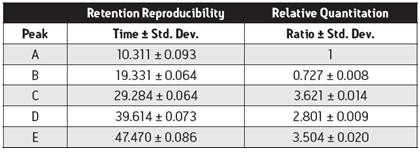
The ACQUITY UPLC H-Class System provides the accuracy and reproducibility of extended batch peptide mapping.
aims
Analytical reproducibility of the ACQUITY UPLC ® H-Class system in long-light elution gradient applications to resolve complex mixtures such as peptide mapping.
background
Peptide mapping is used to identify the primary structure of a protein, identify post-translational modifications (PTM), and analyze potential impurities. Any difference in protein structure should be reflected in the change in retention time of the peptide containing the modification. The relative amount of peptides with and without specific modifications is used to determine the proportion or amount of protein in a particular sample containing the modification.
The change in area ratio corresponds to the amount of protein molecules in the sample containing the particular modification. To meet these application requirements, long and shallow gradient elution is required. These separation conditions have been a challenge in the past for single pump gradient systems. In this study, we tested a typical peptide mapping protocol on the ACQUITY UPLC H-Class system. 
Figure 1. Peptide mapping sample list starts on Friday and runs automatically throughout the weekend. When the staff returns to work on Monday, the data is ready for review. The figure shows every three separations, showing excellent reproducibility, resolution and retention time. As summarized in Table 1, the five labeled peaks, from A to E, were selected as representatives of the quantitative analysis.
Solution
The ACQUITY UPLC H-Class system consists of a Quaternary Solvent Manager (QSM) that flows through a Needle Sample Manager (SM-FTN), a column heater, and a Photodiode Array (PDA) detector. An optional 250μL mixer is installed. The standard peptide solution in the MassPREPTM BSA reagent was separated on an ACQUITY UPLC BEH 300 C 18 reverse phase column. The elution gradient increased by 1.0% for each additional bed volume elution volume and the gradient increased by approximately 0.6% per minute. This gradient was selected as a typical polypeptide mapping gradient.
The program takes full advantage of the instrument's automatic mixing capabilities. Pure solvent reservoirs and concentrated modifier stocks are used to replace binary, pretreated solvents. In this example, the gradient is formed in pure water in line A and pure acetonitrile in line B, and a portion of the stream is drawn from a water reservoir D containing 1% TFA. In the gradient, the ratio of line D is reduced from 5% to 4%, which corresponds to a decrease in TFA concentration from 0.05% to 0.04%, thus minimizing baseline drift.
The peptide map is shown in Figure 1, and the parameters such as retention time and peak area are statistically analyzed in Table 1. Relative retention and resolution remain constant during long series runs. The retention time is fully reproducible to ensure that the peaks are always correctly identified. Taking the area of ​​peak A as a reference, compare peaks B, C, D, and E and calculate the corresponding proportions in each test sample. The ratios of these areas are highly consistent in each test sample (see Table 1), and such accuracy is consistent with our requirement to measure the proportion of modified protein in a series of samples.

Table 1. Summary of chromatographic peak retention time and area ratios. The five peaks selected for quantitative comparison were evenly spaced for 10 min throughout the elution gradient.
to sum up
Mapping for meaningful peptides requires both quantitative and qualitative reproducibility. The ACQUITY UPLC H-Class system provides precise control of peptide separation for large samples, giving analysts confidence in the instrument. It is believed that any retention time deviation indicates a change in sample composition, not due to instrument variability. of. The observed separation meets this goal when utilizing this multi-solvent mixing capability. The design of this system ensures that both quantitative and qualitative results meet the requirements of modern analytical biochemistry.
Waters Technology (Shanghai) Co., Ltd. Address: Room 01, Building 41, 1387 Zhangdong Road, Pudong New Area, Shanghai, China Postcode: 201203
telephone / fax
Insect Sex Pheromone as a chemical communication tool during the reproductive stage between allogeneous insects. The high complexity and specificity of its chemical structure is an important guarantee for reproductive isolation between insect species. Therefore, sex pheromones between different insects cannot The replacement will not cause confusion, which has great practical value in the regional investigation of insects, plant quarantine, and trap control.
In nature, adult females will release a compound called sex Pheromone after sexual maturity. It is released into the air and diffuses with the airflow. It stimulates the chemosensory organs in the male antennae, causing male sexual impulses and lures. The male flies to the release source and mate with the female adult to reproduce offspring. Therefore, insect sex pheromone products are bionic high-tech products, which release artificial sex pheromone through the core.
Insect sex pheromone is a compound that regulates the attraction of male and female insects. It is sensitive and specific. It has a long distance and strong temptation. The use of this product to attract and kill pests does not contact plants and agricultural products, and there is no concern about pesticide residues. It is one of the first methods for controlling pests in modern agricultural ecology.
Currently the most popular insect sex pheromone varieties are: Weevil Sex Pheromone, Asian Corn Borer Sex Pheromone, Cotton Bollworm Sex Pheromone, diamondback moth sex pheromone, glutenous sex pheromone, pear horde worm sex pheromone , Codling moth sex pheromone, soybean heartworm sex pheromone, cowpea viburnum sex pheromone, horsetail pine caterpillar pheromone.
Insect Sex Pheromone
Weevil Sex Pheromone, Asian Corn Borer Sex Pheromone, Cotton Bollworm Sex Pheromone, Plutella xylostella sex pheromone, Grapholitha Molesta Sex pheromone, Soybean Budworm Sex Pheromone, Cowpea Moth Sex Pheromone, Sex Pheromone of Masson-pine Caterpillar
Taizhou Volsen Chemical Co., Ltd. , https://www.volsenchem.com